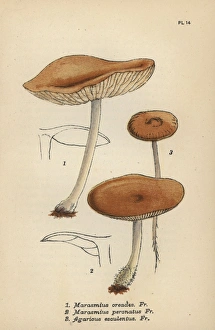Marasmius Collection
Marasmius, also known as the Fairy Ring Champignon, is a fascinating genus of mushrooms that captivates both nature enthusiasts and mycologists alike
All Professionally Made to Order for Quick Shipping
Marasmius, also known as the Fairy Ring Champignon, is a fascinating genus of mushrooms that captivates both nature enthusiasts and mycologists alike. One prominent member of this group is Marasmius oreades, commonly referred to as the Scotch bonnet or fairy ring mushroom. With its delicate appearance and enchanting name, Marasmius oreades has earned its place in folklore and literature. It often forms beautiful fairy rings – circular arrangements of mushrooms that seem like portals to another realm. These mesmerizing formations have inspired countless tales of magical creatures dancing under moonlit nights. Another notable species within the Marasmius family is Gymnopus peronatus, affectionately called Wood Woollyfoot. This mushroom possesses a unique feature - its stem appears covered in fine wool-like fibers, giving it an extraordinary texture. In botanical plates dating back to 1900, we can see vivid depictions showcasing both Good and Bad Mushrooms. Among them stands the elegant Fairy-Ring Champignon (Marasmius oreades), with its distinctive cap shape and gills underneath. Various pictures numbered from 11050602 to 11050599 offer glimpses into the captivating world of these fungi. From their intricate structures to their earthy colors, each image showcases the beauty hidden within these humble organisms. Combining culinary delights with natural wonders, one high-angle view presents a plate adorned with Fairy Ring Champignons alongside a perfectly poached egg on toast. The harmonious blend of flavors mirrors nature's harmony found in symbiotic relationships between plants and fungi. Even historical engravings from 1875 depict Marasmius oreades through detailed line work—a testament to humanity's long-standing fascination with these remarkable organisms. Whether you stumble upon them during a woodland stroll or admire them on your plate at dinner time, mushrooms like those belonging to the Marasmius genus remind us of the intricate beauty that exists in our natural world.











